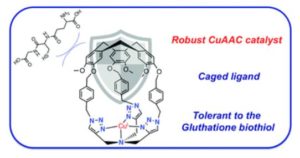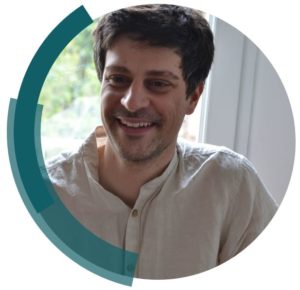This week, we bring you our ChemComm Milestones interview with Cédric Colomban who recently published his #ChemComm1st article. Read ‘A tris(benzyltriazolemethyl)amine-based cage as a CuAAC ligand tolerant to exogeneous bulky nucleophiles‘ in our First Independent Article collection.
Here’s our interview with Cédric:
What are the main areas of research in your lab and what motivated you to take this direction?
My lab, the Bioinspired Confined Catalysis group (BCC), was established in 2020 and is interested in caged bioinorganic complexes for efficient and selective catalytic transformations in confined spaces. Since my Msc’s studies I am amazed by the fascinating reactivity of the nature’s catalysts that are enzymes (and in particular metalloproteins). My research interests have always been inspired by these systems with (i) artificial models reproducing their active sites (PhD on bioinspired catalysts), and (ii) receptors inspired by their tridimensional architectures (postdocs on supramolecular cages). In this line, the BCC group merges these approaches to develop bioinorganic confined catalysts.
Can you set this article in a wider context?
Due to its broad range of applications (chemical biology, material science, interlocked structures), the Cu-catalyzed azide-alkyne cycloaddition reaction (CuAAC) is the most popular transformation of the “click chemistry” toolbox. Many efforts have been devoted to assisting ligands that improve the reaction efficiency and, among them, the tris(benzyltriazolemethyl)amine TBTA has been the most widely used CuI-coordinating structure. However, the recent emergence of CuAAC biorthogonal chemistry has revealed the ongoing need for catalysts that remain active in complex mixtures, such as living systems, where they have to face the competition of bulky CuI-chelators (mainly reduced gluthathione GSH). In this context, the challenge is to develop CuAAC-ligands tolerant to exogeneous bulky nucleophiles such as biothiols.
In this work, we get inspiration from the enzyme hydrophobic pockets, to reach an efficient protection of the TBTA-Cu(I) active core. The canonical ligand was equipped with a bowl-shaped cap to yield the first TBTA-based organic cage. We demonstrate that our shielded ligand remarkably protect the Cu-center from it deactivation by GSH, without suffering from product inhibition effect, opening the way to efficient CuAAC transformations in complex media.
What do you hope your lab can achieve in the coming year?
Findings and funding! First of all, like every research team, I am hoping to return to easier working conditions and to be allowed to attend conferences. This will help the students to keep growing as researchers, and to develop research-networks. Various exciting findings have been recently made in the BCC group regarding Cu and Fe-catalysis and we hope that theses preliminary results will became groundbreaking discoveries. In particular, I am hoping to continue our pioneering research in the field of Bioinspired Confined Catalysis, thanks to funded projects.
Describe your journey to becoming an independent researcher.
After finishing my Msc in bio-organic and bio-inorganic chemistry at the University Grenoble-Alpes, I completed my Ph.D. studies (University of Lyon, France) on bioinspired homogeneous catalysis using porphyrin-like diiron complexes (A. Sorokin group, IRCELYON). After this experience with “open” models, I chose to pursue my research in the field of supramolecular cages and host-guest interactions, and undertook my 1st postdoc on self-assembled cages at the University of Girona, Spain (M. Costas and X. Ribas group, IQCC). Having explored the field of multicharged metallacages, I then decided to focus on purely organic receptors and I completed a 2nd postdoc in the A. Martinez group (Ecole centrale of Marseille, iSm2, France). Finally, in 2020, I was ranked 1st at the highly competitive French-CNRS recruitment contest and become independent researcher at the institute of molecular sciences of Marseille, iSm2, France (BCC group).
What is the best piece of advice you have ever been given?
When I was a PhD student I once asked my supervisor (Alexander Sorokin) if I could try one particular experiment, and his answer was: “Cédric, if we are doing this job, it is to try everything we want!”. Behind these worlds the idea was: important discoveries often arise from unusual experiments, and researchers should pursue their weird ideas without being afraid of failure. As a mentor I am now applying this advice by encouraging students’ creativity.
Why did you choose to publish in ChemComm?
Being a leading journal in general chemistry, and having short format articles, ChemComm has always been part of my favorite journals as a reader. As an author, ChemComm present the advantage of fast publication time and high impact. The journal was therefore perfectly suited to this work that aims at delivering one key message: CuAAC transformations in complex media could be achieved thanks to caged-ligands.
Find out more about ChemComm Milestones on our Twitter – follow the hashtag #ChemComm1st












